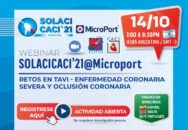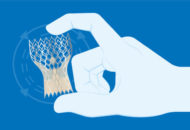Troponins have long had diagnostic value not only for infarction. Their ability to predict mortality is well established for all cardiac conditions. Moreover, it has been demonstrated in all critically ill patients, including patients with COVID-19, regardless of the triggering condition. While their significance in COVID cases is backed by the literature, there was not…
Fluoroscopy vs. Ultrasound Guided Femoral Access in TAVR
Ideally, we will not puncture the femoral artery blindly if we are planning to use a big caliber releasing device and a percutaneous closure device during TAVR. The risk of a high or low puncture or the presence of a lateral branch compromising the puncture site might become a major vascular and bleeding complication. There…
SOLACI-CACI 2021 Webinar | Challenges in TAVI – Severe CAD & Coronary Occlusion
Next Thursday, October 14, we will hold a joint event between SOLACI, CACI and the Microport company on “Challenges in TAVI: Severe Coronary Disease and Coronary Occlusion”. The activity is part of the satellite events of the SOLACI-CACI 2021 Congress and, as such, will have the participation of important international and Latin American speakers. Date:…
The FDA Approves a Third Device in the TAVR Race
The Portico self-expanding graft has obtained FDA approval and can now compete as one of the three options available in clinical practice for transcatheter aortic valve replacement (TAVR) in the United States. For the time being, its indication will have some restrictions: for example, it can only be used in high-risk patients (unlike CoreValve and…
The latest scientific articles on TAVI published on our website
01- TAVR and Anticoagulation: Direct Anticoagulant Agents or Vitamin K Inhibitors? In some patients, using an anticoagulant agent is not an option, it is just prescribed. Based on the French TAVR registry, this research compared long-term mortality, bleeding, and ischemic events after valve implantation. A comparison was made between TAVR and direct vs. classic anticoagulant agents—good old proven and reversible vitamin K inhibitors. Read also HERE 02-…
ESC 2021 | ENVISAGE-TAVI AF: Surprise with Endoxaban in TAVR and Atrial Fibrillation
The enthusiasm for direct oral anticoagulants after transcatheter aortic valve replacements (TAVR) is waning. At least, when it combines with atrial fibrillation. The ENVISAGE-TAVI AF has shown excessive bleeding with endoxaban vs. the classical vitamin K antagonists. Endoxaban resulted non-inferior to vitamin K antagonists in terms of net clinical adverse events, but major bleeding events…
Watch Again our Webinar on Challenges in TAVR: Evidence, Complex Anatomies, Durability
Watch Again our Webinar on “Challenges in TAVR: Evidence, Complex Anatomies, Durability”.
TAVR Durability Becomes Irrelevant after TRANSIT Outcomes
The international registry TRANSIT has shown treating degenerated transcatheter aortic valves (TAVs) with a second TAVR is safe and effective. These finding are of crucial importance to the definite adoption of TAVR in the lower risk, younger population. Transcatheter aortic valve replacement (TAVR) has determined a paradigm shift in severe aortic stenosis treatment. Technological innovation…
Direct TAVR vs. Predilation: Potential Cost of a Simpler Procedure
Does simplifying TAVR involve a cost? At least for low-risk patients included in the PARTNER 3, the question appears somewhat abstract. Predilation and direct TAVR resulted equally safe, though the latter shortened procedural time and did not require further post dilation. Both strategies resulted virtually identical in terms of clinical events. The use of predilation…









